I want to calculate the integral of a sequence vector. Since there's no function available, I use the trapezoidal method1.
iglTzm <- function(x, y) sum(diff(x) * (head(y, -1) + tail(y, -1))) / 2
The first element of the sequence should be the zero point, so the principle is: if the values of the sequence are predominantly below the first value, the integral should be negative, otherwise positive, or 0.
Consider matrix m1:
[,1] [,2] [,3] [,4] [,5] [,6] [,7]
[1,] 6 7 8 8 6 8 10
[2,] 9 9 8 9 9 8 9
[3,] 9 10 10 9 9 9 9
[4,] 9 8 8 8 6 8 9
[5,] 10 10 10 9 10 8 0
[6,] 9 8 9 10 9 9 9
Integration with these raw values will most likely lead to inconsistent values:
> setNames(apply(m1, 1, iglTzm, 0:6), 1:6)
1 2 3 4 5 6
15 2 -2 7 -52 0
So I adjust the sequences (rows) on their first value (column 1), in order to set the right signs, and get matrix m2:
[,1] [,2] [,3] [,4] [,5] [,6] [,7]
[1,] 0 1 2 2 0 2 4
[2,] 0 0 -1 0 0 -1 0
[3,] 0 1 1 0 0 0 0
[4,] 0 -1 -1 -1 -3 -1 0
[5,] 0 0 0 -1 0 -2 -10
[6,] 0 -1 0 1 0 0 0
Logically that doesn't change anything about the values iglTzm() throws, because the diff() is the same:
> setNames(apply(m2, 1, iglTzm, 0:6), 1:6)
1 2 3 4 5 6
15 2 -2 7 -52 0
Anyway, because I can't simply scale or invert it, I haven't had a brilliant idea yet how to adapt the function to get the right signs, which are assumingly:
# 1 2 3 4 5 6
# 15 -2 2 -7 -52 0
Does anyone know how to adapt iglTzm() to get the integrals with the correct sign?
The plot of m2 should illustrate the principle a bit more:
data
m1 <- matrix(c(6, 7, 8, 8, 6, 8, 10,
9, 9, 8, 9, 9, 8, 9,
9, 10, 10, 9, 9, 9, 9,
9, 8, 8, 8, 6, 8, 9,
10, 10, 10, 9, 10, 8, 0,
9, 8, 9, 10, 9, 9, 9), 6, byrow=TRUE)
m2 <- t(apply(m1, 1, function(x) scale(x, center=x[1], scale=FALSE)))
# plot
par(mfrow=c(2, 3))
lapply(1:nrow(m2), function(x) {
plot(m2[x, ], type="l", main=x)
abline(h=m2[x, 1], col="red", lty=2)
})
